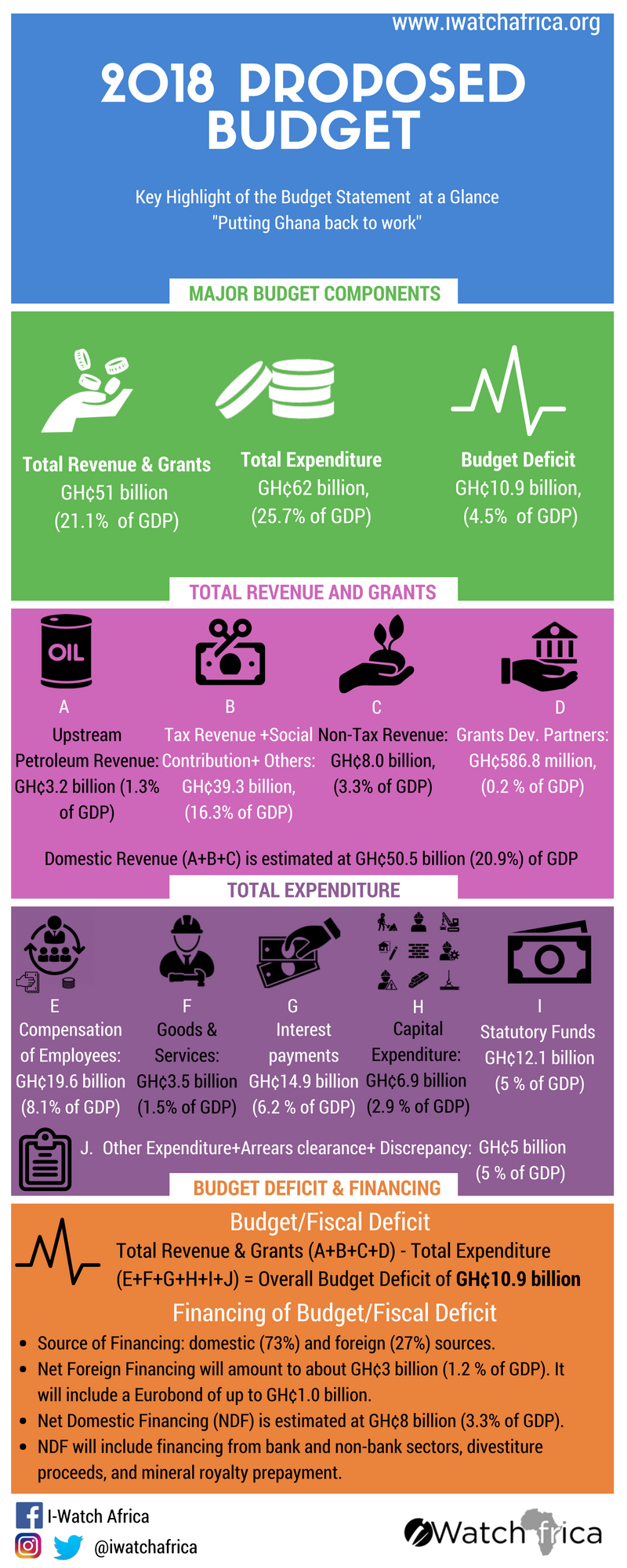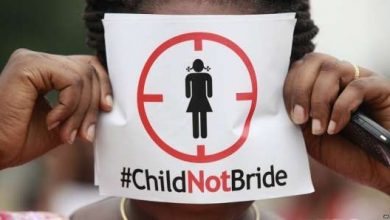
Key Highlights of the 2018 Budget Statement [Infographic]
Tracking the 2018 Budget Statement
Based on the government policy objective of ensuring macroeconomic stability, and growing the economy for job creation, whilst protecting social spending, the following macroeconomic targets are set for the 2018 fiscal year with an estimated budget size of GH¢51 billion (see infographic):
- Overall GDP growth rate of 6.8 percent;
- Non-oil GDP growth rate of 5.4 percent;
- End-period inflation rate of 8.9 percent;
- Average inflation rate of 9.8 percent;
- Fiscal deficit of 4.5% percent GDP;
- Primary balance (surplus) of 1.6 percent of GDP; and
- Gross Foreign Assets to cover at least 3.5 months of imports of goods and services
Similarly, the fiscal programme is firmly anchored on the ongoing fiscal consolidation. The prime focus is to ensure that the fiscal deficit, which remains the principal fiscal anchor, is programmed to decline to 4.5 percent of GDP from the projected 2017 end-year estimate of 6.3 percent. Over the medium term, the fiscal deficit is expected to stabilize around 3-5 percent of GDP.
The country will be faced with rising expenditures over the short to medium term, as the government invests more in programmes that will stimulate economic growth and generate jobs. The government will, therefore, need to boost domestic revenue through innovative channels that will not place an undue burden on the entire populace. In this vein, optimizing resource mobilization through improved tax compliance and efficient and effective revenue administration remains an important part of the government fiscal strategy to boost domestic revenue mobilization for 2018 and the medium term. Consequently, in addition to empowering the Ghana Revenue Authority (GRA) to bring to book tax evaders. The government is equally investing in programmes and infrastructure to widen the tax net. This will include the implementation and rollout of a National Digital Address System (to help us track taxpayers especially in the informal sector), an acceleration of the implementation of the National Identification Programme, deployment of Electronic Point of Sale devices (to ensure that vendors are not under declaring VAT), and special audits, among others.
On expenditure front, the government has shown commitment to eliminate expenditure overruns and will remain committed to continuing with the design and implementation of the Public Financial Management reforms with the aim of eliminating inefficient and ineffective allocation of resources.
The proposed 2018 budget has total revenue and expenditure an estimated GH¢51 billion and GH¢62 billion respectively (see infographic).

Government Revenue Mobilisation for 2018
Total Revenue and Grants for the 2018 fiscal year has been conservatively estimated at GH¢51 billion based on the Government’s projection of the level of economic activity in 2018, policy on taxation and donor grant disbursements. Domestic Revenue is estimated at GH¢50.5 billion, representing an annual growth of 26.9 percent. The following are components and estimates of government revenue for 2018 (see infographic);
- Total Receipts from upstream petroleum activities amount to GH¢3.2 billion and estimated at 6.2 percent of Total Revenue and Grants. This is about 1.3 percent of GDP and represents a per annum growth of 24.8 percent over the 2017 projected outturn.
- Non-Tax Revenue is estimated at GH¢8.0 billion, equivalent to 3.3 percent of GDP. Of this amount, internally generated funds to be retained by IGF-generating institutions amount to GH¢3.8 billion.
- Grants from Development Partners mainly in support of projects are estimated at GH¢586.8 million, equivalent to 0.2 percent of GDP. We do not expect to receive any programme It is important to note that, as a Middle-income country, these donor resources will cease with time, emphasizing
Government Expenditure for 2018
The Total Expenditure, including provision made for the clearance of arrears, is estimated at GH¢62 billion, equivalent to 25.7 percent of GDP. The estimated expenditure for the year represents an annual growth of 14.5 percent. The subsequent bullets are the major components and estimates of government expenditure for 2018 (see infographic);
- Compensation of Employees continues to represent the single largest item of government expenditure; it is estimated at GH¢19.6 billion (8.1 percent of GDP). Of this amount, GH¢16.8 billion, equivalent to 6.9 percent of GDP has been provisioned for Wages and Salaries alone.
- Expenditure on Goods and Services is estimated at GH¢3.5 billion, representing 1.5 percent of GDP. The annual growth of 56.9 percent reflects a full provision made to cater for the Government’s priority programmes, including the flagship Free SHS policy which enters its second year of implementation in 2018.
- Interest payments are estimated at GH¢14.9 billion (6.2 percent of GDP). Of this amount, Domestic Interest Payment constitutes about 82 percent. As we consolidate our public finances, the annual growth of domestic interest payments is expected to decline considerably. It must be noted that the debt reprofiling exercise is having a positive impact on interest payments.
- Transfers to Statutory Funds as well as all other earmarked funds which are backed by the relevant Laws are estimated at GH¢12.1 billion. the objective of the Statutory Funds is to provide secure funding to implement critical programs and projects in the relevant sectors. Over the years, these sectors have been exerting a lot of pressure on the limited available resources despite allocations to the Statutory Funds. In consonance with the PFM Act, 2016 (Act 921), and Earmarked Funds Capping and Realignment Act, the earmarked funds will be realigned to national priorities.
- Allocations for Capital Expenditure is GH¢6.9 billion. Of this amount, domestically financed Capital Expenditure is estimated at GH¢3.3 billion or 1.4 percent of GDP. This represents an annual growth of about 219 percent. An amount of GH¢3.6 billion has been budgeted from foreign-financed capital expenditure and this will be funded by a combination of donor project grants and project loans.
Overall Budget Deficit and Financing for 2018
Based on the estimates for Government total revenue and total expenditure, the 2018 budget will result in an overall budget deficit of GH¢10.9 billion, equivalent to 4.5 percent of GDP (see infographic).
Financing of the fiscal deficit will be from both domestic and foreign sources. Net Foreign Financing will amount to about GH¢3 billion (including a Eurobond of up to GH¢1.0 billion), equivalent to 1.2 percent of GDP. Net Domestic Financing (NDF) will constitute about 73 percent of total financing and includes financing from bank and non-bank sectors, other domestic sources such as divestiture proceeds and mineral royalty prepayment. The total NDF is estimated at GH¢8 billion or 3.3 percent of GDP.
It is worth noting that in 2018, the primary balance, which is an indication of our fiscal effort will be grown to a larger surplus of about 1.6 percent of GDP from the projected 2017 outturn of 0.2 percent. This signifies our resolve to “breaking the back” of a growing public debt from the previous year.
Reference: 2018 Budget Statement by Finance Minister, Ken Ofori-Atta accessed on 14 November 2017
Article prepared: Moro Seidu| iWatch Africa


